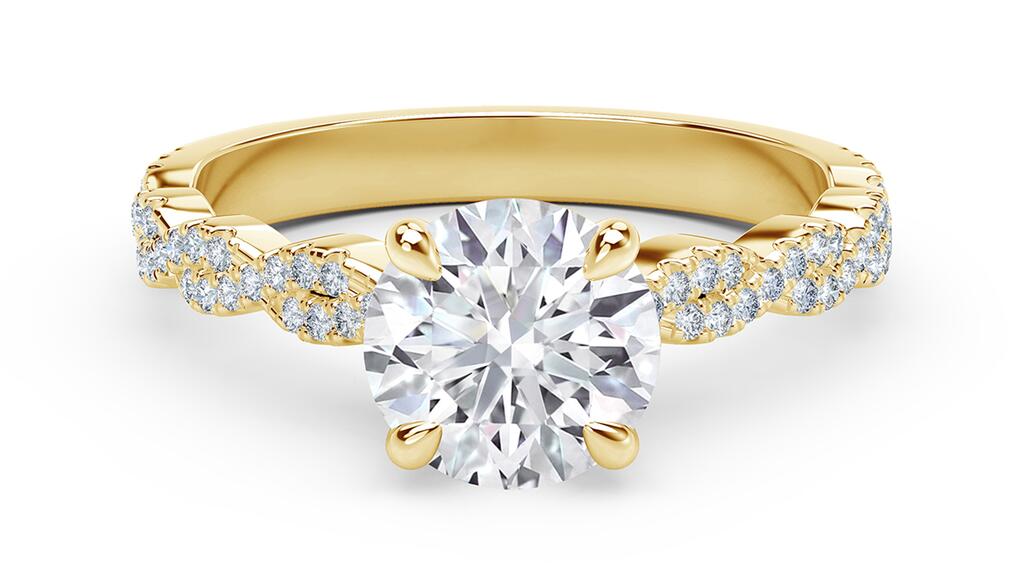Here Are the Results of The Knot’s 2021 Jewelry & Engagement Study
Lab-grown center stones and yellow gold are on the rise.

The annual report highlights the top trends in marriage proposals. This year, 5,000 individuals across the United States aged 18-54 who got engaged between January and November 2021 responded.
On the jewelry front, diamond rings remain king, with 93 percent of respondents saying their proposal included a ring, and 86 percent a diamond ring.
Forty-one percent of respondents said they favored a round diamond, and 19 percent an oval cut, up from 2 percent in 2015.
The average diamond size among The Knot’s survey respondents was 1.5 carats, though about 25 percent said they gave or received rings with diamonds weighing more than 2 carats.
When it came to non-diamond stones, the most popular option was moissanite, favored by 28 percent of respondents who opted for a gem other than a diamond. This was up from 9 percent in 2019, pre-pandemic. The consumers who most often chose this stone, which is less expensive than a diamond, were the Gen-Z respondents.
A growing number of survey-takers indicated it was becoming less important to them that their engagement ring stone be natural rather than lab-grown (34 percent said it was important that a stone be natural in 2021, versus 42 percent in 2019).
Overall, almost a quarter of engagement rings exchanged by survey-takers featured a man-made stone, such as a lab-grown diamond, up 11 percent since 2019.
In terms of ring settings, yellow gold has increased in popularity for engagement rings, growing 11 percent since 2017. White gold, on the contrary, declined from being used in 61 percent of rings according to the survey in 2017 to 45 percent in 2021.
When it came to couples’ methods for ring shopping, online channels like social media and jewelry websites served as first stops for inspiration and research, but most shoppers made their purchases in store.
Sixty-seven percent of rings were purchased in-store and half at local jewelers.
Proposers visited an average of two to three retailers, scoping out about 10 ring styles before making their decision.
According to the survey, average engagement ring spend pre-pandemic was $5,900 in 2019, and held steady in 2021 at $6,000.

The average natural white diamond engagement ring purchased by survey-takers cost $6,800, while rings set with other gemstones, whether lab-grown or colored gemstones, cost an average of $2,500.
Consumers spent more depending on age: an average $6,700 for millennials and $4,100 for Gen-Z.
Additionally, two out of three shoppers stuck to a budget, while almost 30 percent spent more than planned, up 9 percent since 2019.
The Knot’s survey went beyond engagement ring preferences to span other aspects of popping the question.
A major trend was the increase in outdoor engagements, up from 40 percent in 2020 to 73 percent in 2021.
Proposals have also become more elaborate, with an increased number of survey-takers saying they hire vendors, like photographers, for the occasion (19 percent, up from 12 percent in 2019).
Thirty-five percent of outdoor engagements took place at a scenic spot, while almost one in three happened during a planned trip, up 7 percent from 2020 when travel was more restricted.
As COVID-19 restrictions diminished this year, one in four respondents said they felt pressure to make their proposal unique, in line with pre-pandemic figures.
More than 90 percent announced their engagements on social media, via Instagram (78 percent), Facebook (77 percent), or Snapchat (20 percent).
More than three-quarters of respondents have set their 2022 wedding dates, with fall the most popular season. Sixty percent began planning their nuptials within a month of engagement and 85 percent within two months.
Most couples (89 percent) said they spoke about at least one aspect of their wedding pre-engagement, and almost 70 percent took at least one wedding planning action.
Seventy percent of survey-takers dated for two years or more prior to getting engaged, and one in four said they met their partner online. That percentage was higher among older respondents, with 35 percent of those aged 35 and up meeting online.
Tinder was the most popular platform (27 percent), followed by Bumble (23 percent), and Hinge (21 percent).
“We’re thrilled to see that proposals are returning to pre-pandemic behaviors. The majority of couples are already booking their weddings for 2022, as the wedding boom is upon us,” said Shelley Brown, senior fashion and beauty editor at The Knot.
“With this renewed excitement surrounding proposals comes an increased interest in highly personalized engagement rings. Oval diamonds, yellow gold settings and alternative center stones like moissanite and sapphire are all gaining popularity, speaking to couples’ increasing desire to invest in wedding traditions that represent their specific love story and personal taste.”

Right before Thanksgiving, The Knot also released a study conducted in partnership with De Beers Group on engagement expectations, surveying 300 women in a serious relationship.
Most women said they wanted one partner to propose to another (98 percent), and for it to be planned (66 percent), and in a private place (66 percent).
Ninety-six percent wanted to be involved in the ring selection, even if their partner was proposing to them, while a majority did not want the proposal to be a total surprise.
Three-quarters of the respondents said they had given a lot of thought, or some thought, to possible engagement rings.
A diamond was the most popular center stone preference with women more invested in the shape, style and setting rather than stone size.
Seventy-six percent of respondents expect their partner to pay for 100 percent of the ring cost, while the remainder expect to contribute.
Overall, 85 percent believe there is more pressure around proposals today than in their parents’ generations, while 68 percent said ring designs are more unique today.
The Knot and De Beers Group Engagement Expectations Study was conducted in October 2021 via Instagram.
The majority of respondents were aged 18 to 34 and believed they would be engaged within two years.
The Latest

Executive Chairman Richard Baker will take over the role as rumors swirl that a bankruptcy filing is imminent for the troubled retailer.

Mohr had just retired in June after more than two decades as Couture’s retailer liaison.

Shekhar Shah of Real Gems Inc. will serve as president of the Indian Diamond & Colorstone Association in 2026.

How Jewelers of America’s 20 Under 40 are leading to ensure a brighter future for the jewelry industry.

This year’s good luck charm features the mythical horse Pegasus, and is our first Piece of the Week of the new year.


Articles about crime, engagement rings, and a necklace worn in the World Series generated the most interest among readers.

As part of the leadership transition, Sherry Smith will take on the role of vice president of coaching strategy and development.

Roseco’s 704-page catalog showcases new lab-grown diamonds, findings, tools & more—available in print or interactive digital editions.

It marks the third time the country has headed the Kimberley Process. Ghana will serve as vice chair.

The new Bulova x Stetson designs highlight two animals often associated with the American West—the bison and the Texas Longhorn.

Its residency at Yamron Jewelers will run through May 2026.

From influential executives to innovative designers, we pay tribute to the people we said goodbye to this year.

The retailer is expanding into areas with large Indian and South Asian populations.

The Italian brand has opened its first flagship amid the peaks of the Dolomites in Madonna di Campiglio, Italy.

The new curation at the Natural History Museum of Los Angeles County showcases rare gem and mineral specimens in their uncut, natural state.

The couple pleaded guilty to concealing at least $127 million in cash transactions at its precious metals businesses.

In February 2026, the auction house will move its headquarters to the former Steinway Hall, a neoclassical landmark on Billionaires’ Row.

The new show will take place Jan. 23-25, 2026.

The former BHP Billiton leader and Gemfields chairman is remembered for his influential leadership throughout his 50-year mining career.

The LVMH-owned brand has partnered with the costume design union to revamp its award for 2026.

The luxury titan inked a deal to acquire an initial minority stake in the jewelry manufacturer with a pathway to full ownership by 2032.

The company’s curation of unsigned vintage and estate jewelry debuted at the Bloomingdale’s in Costa Mesa, California.

In the recent multi-shipment seizure, CBP also found counterfeit Audemars Piguet, Moncler, and Chrome Hearts items.

Helzberg’s Chief Retail Officer Mitch Maggart shared details about its tests of a new store concept rooted in an elevated luxury experience.

Jewelers of America execs and National Jeweler editors discuss tariffs, the sky-high gold price, and the engagement that broke the internet.

The luxury goods company said founder Ippolita Rostagno will remain at the brand’s helm.

Laura Burdese, who joined the Italian luxury brand in 2022, will take on the role in July.



























